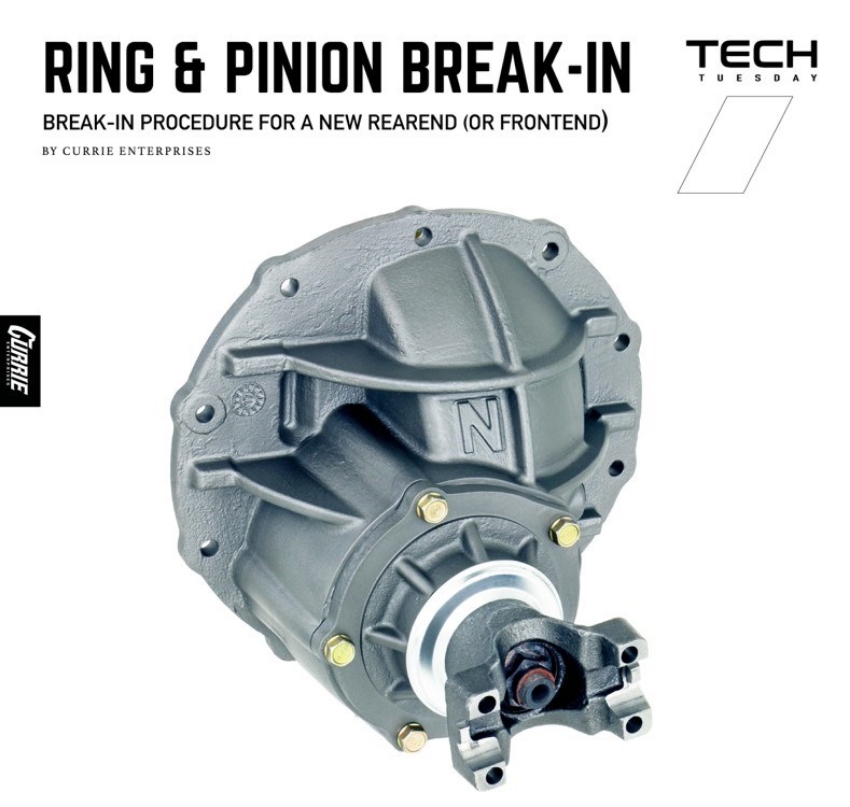The break-in procedure for a new rear end (or front end) is a relatively simple task; however, it needs to be done correctly to ensure a long-lasting setup. The idea is to mate the ring and pinion gear tooth surfaces together, which, if done improperly, can lead to premature gear wear – however, it's not as complicated as it sounds. Because the ring and pinion are machined separately at the factory, it's important to "introduce" these surfaces together by putting a load on the setup, letting it cool, and then progressively adding more load (speed) until the gears are in sync with each other. This is easily achieved by simply "cruising" your vehicle at typical street speeds in specific steps. At Currie, we recommend the initial break-in to start by driving normally for 15-20 minutes (no burnouts, hard starts, or highway driving), then letting the vehicle rest for 30 minutes, never going over 50 miles without letting it cool. Towing and high speeds should also be avoided until after the break-in (300-500 miles). Once this is achieved, we recommend you change the oil.
Break-in Tips:
Street Driving
Drive normally on streets for approximately 15-20 minutes, stop, and then let the rear end cool down for 30 minutes. The process should be repeated two to three times. The oil should be changed at 500 miles. Don't be alarmed if this first oil change comes out much darker than when it went in, as the black phosphate coating is wearing off the gears, along with a minimal amount of steel from the bearings, gears, and differential wearing in.
Towing Vehicles
Drive at low loads for a total of approximately 300 to 500 miles of mixed street (see above) and highway driving before towing any load.
Drag Race Vehicles
Due to the short duration of use and low potential for heat build-up, it is only necessary to perform an initial run-in with the driven wheels off the ground, the vehicle idling in high gear for approximately 15 minutes, and then allow the rear end to cool. Once this initial heat/cool cycle has been completed, many will further break in the gears with a quick burnout or even a short track run before changing to fresh gear oil.
Off-Road Vehicles
The break-in procedure for off-road vehicles such as Jeeps and trucks is the same as it is for street-driven vehicles. When breaking in new gears or axle assemblies on the trail, avoid sand washes, big whoops, and inclines, as these can load the gears prematurely.
Break-In Alternatives
REM® Gear Polishing
The REM ISF® (Isotropic Superfinish) process uses a proprietary combination of vibratory finishing equipment and refinement chemicals to achieve a smooth micro-textured finish that reduces friction, improves oil retention, and increases gear durability. Additionally, REM polishing eliminates the need to perform the standard break-in procedure. However, a 500-mile oil change is still required to remove contaminants from the break-in of other components, such as the bearings and differential. REM polishing is available for an additional charge for all ring and pinion gear sets purchased from Currie.
Dyno Break-in
Currie offers a dyno break-in service for new or rebuilt 9-inch third members that go through our shop as an alternative to the traditional break-in procedure. The dyno brake-in procedure spins the third member in a fixtured rear end for 20 minutes to allow the unit to reach operating temperature, after which it's allowed to cool, completing the initial run-in of the gears and bearings. The dyno break-in service is available for a fee and can help save some time and ensure your third member is quiet.

